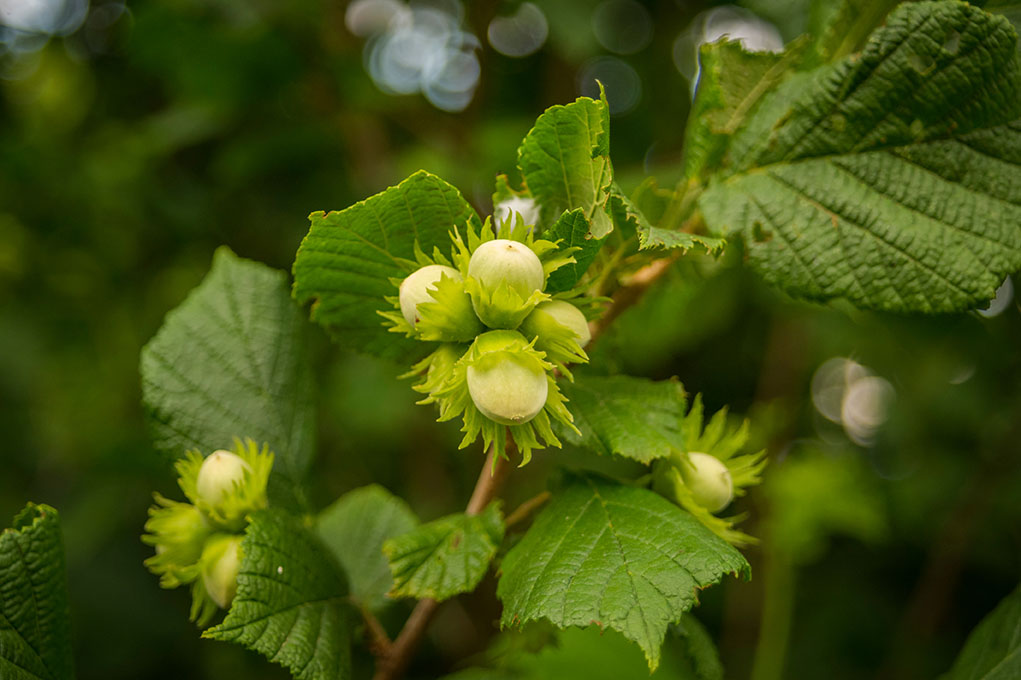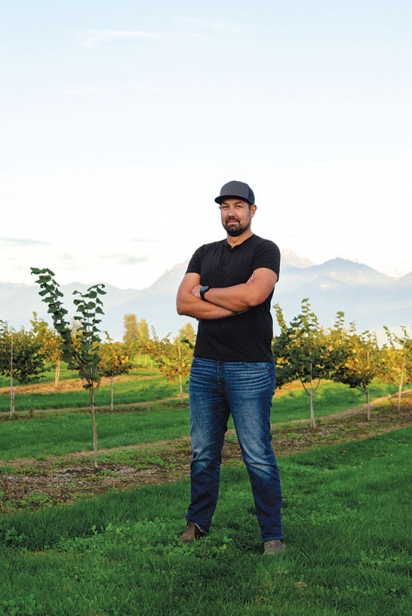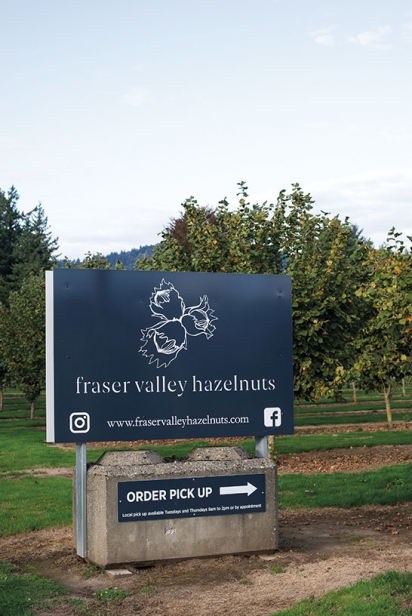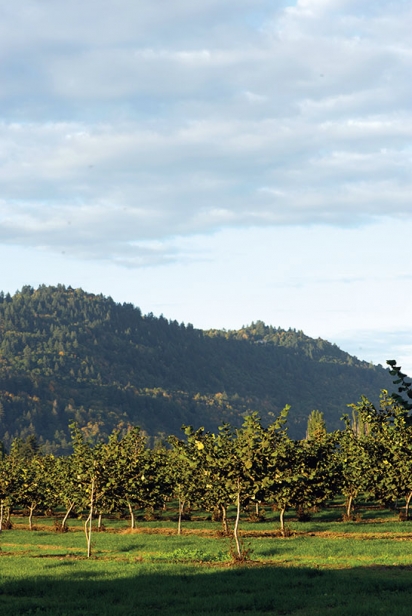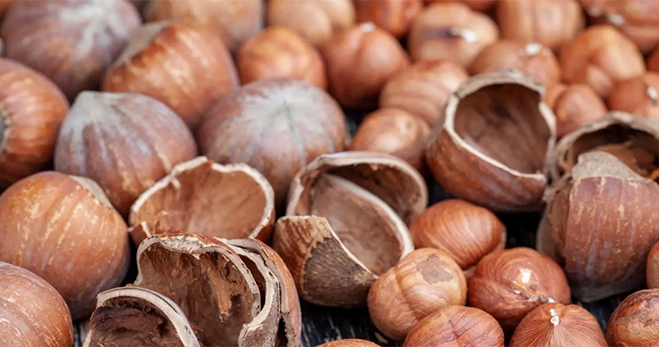Farming the Resilient Filbert
You might think about jars of chocolatey Nutella or Ferrero Rocher truffles when you think of hazelnuts, but the wild beaked hazelnut has been gathered and consumed by Canada’s Indigenous people, including many B.C. First Nations, for thousands of years.
While farmed commerically in the Pacific Northwest for nearly a century, the European hazelnut cultivar's roots go much deeper.
Native hazelnuts — both beaked cornuta and californica — are found along B.C. coastal regions, the latter on Vancouver Island and the Lower Mainland, with a distinct variation growing around Hazelton in North Central B.C. It’s a shrub that can grow up to 10 metres (30 feet) tall in the wild, bearing clusters of small, round nuts encased in tough pointed or “beaked” husks.
The hazelnut was an important plant for coastal and interior Salish people, who used the nuts for food, the straight stems for arrows and to weave into baskets, and the oily shells for fuel, also extracting an intense blue dye from the roots. These nuts were stored as a winter food; traded throughout Ts’msyen, Gitxsan and Wet’suwet’en traditional territories; and planted all along the Skeena River valley. When settlers arrived at the junction of the Skeena and Bulkley Rivers in the 1860s, they named the town Hazelton for the wild hazelnuts growing there.
Commercial hazelnut growers
Fast forward to the 21st century, and though wild hazelnuts can still be foraged in B.C., it’s the cultivated nuts that are gaining popularity with farmers and chefs.
But it hasn’t always been easy for local hazelnut growers.
In 2006, there were 1,200 acres of hazelnut orchards in B.C. — 800 acres in the Fraser Valley alone — producing more than two million pounds of nuts annually.
Then, in 2010, the Eastern filbert blight, a fungal infection that had been circulating across North America, moved west from Ontario into B.C. Carried by the wind, the blight decimated the industry, destroying close to 95 per cent of the commercial hazelnut orchards in just a few years, and resulting in three processors closing their doors.
Since then, B.C.’s commercial nut growers have been in rebuilding mode. With help from the provincial government, hundreds of acres of dead and diseased orchards have been removed and replanted with disease-resistant varieties developed in Oregon (the centre of U.S. commercial production).
And though the annual harvest in B.C. declined to less than 40,000 pounds, Steve Hope says the industry is rebounding.
In 2016, Hope and his partners revived a dilapidated processing facility in Chilliwack and opened Fraser Valley Hazelnuts, now processing and distributing most of the B.C. crop, from Lower Mainland and Vancouver Island farms.
“We are the only commercial-scale processor in the province,” says Hope of the family-run company that buys hazelnuts from 27 B.C. farms.
“We also have 38 acres planted here, with 20 starting to produce last year,” he adds. “We processed 190,000 pounds of hazelnuts in 2022, definitely down from the height of things, but we’re hoping to see yields doubling every year.”
From replanting to plating
While native beaked hazelnuts grow on large shrubs, commercial nuts are produced on trees with a single trunk, about 10 feet tall.
“Hazelnuts are planted in rows, similar to an apple orchard,” says Hope, noting there are a dozen varieties planted on the West Coast that vary in size and shape. Yamhill, a blight-resistant variety developed by Oregon State University, is now a common cultivar in B.C.
The drooping yellow catkins emerge before the leaves in early spring and release pollen to fertilize the buds, which become hazelnuts. The nuts grow in clusters of three or four, encased in a leafy husk that drops from the tree to the ground in the fall. Harvesting and processing takes place in late September and early October.
A harvester — “kind of like a vacuum on wheels” — picks up the two-centimetre balls and removes the husks, then deposits the nuts into 1,500-pound pallets for delivery to the processing plant. A blower removes any remaining husks, the nuts are washed and then go into dryers for 24 to 45 hours. With the right moisture content, and when stored in cool, dry conditions, the hazelnuts will last for a year or more in the shell.
Hope says Fraser Valley Hazelnuts acts as a receiving and processing station for commercial hazelnut growers, and as a distributor for a variety of value-added hazelnut products, including plain roasted hazelnuts, diced roasted hazelnuts, hazelnut meal, and milk- and dark chocolate-covered hazelnuts, created by a chocolatier in Abbotsford. You can find their products at several small retailers, including the Lepp Farm Market in Abbotsford, or order directly from the company’s online shop.
“We have added a cracking line, with a digital sorter, and a roasting line, with brushes to take off the skins,” Hope says. “And we sell them at farmers’ markets, and from our website, or to retailers and restaurants. We sell hazelnuts in bulk quantities to chefs all over B.C.”
One of Fraser Valley Hazelnut’s most loyal customers is chef Devon Latte of The Acorn in Vancouver. After meeting Hope and his partner at the Every Chef Needs a Farmer, Every Farmer Needs a Chef conference in 2019, Latte made “a huge transition in the restaurant.”
“Prior to learning that there is someone who grows hazelnuts in the Fraser Valley — an exciting discovery — The Acorn previously relied on cashews, almonds, pecans and pistachios that weren’t sourced locally, making their traceability difficult to follow,” writes the chef on the vegetarian restaurant’s website. “With Fraser Valley Hazelnuts, we know exactly where their products are coming from, all the while being able to support local.”
Though Latte recently left The Acorn kitchens, B.C. hazelnuts remain on the menu at the award-winning restaurant, served in dishes including Hand Pulled Red Spring Noodles with Hazelnut Dan Dan and Bok Choy, Espelette Pepper, Burnt Onion, Mint, Shallot and Hazelnut.
Hope says his hazelnuts are on the menu at other restaurants, too, from Forage in Vancouver to the Naramata Inn. And the sweet flavour of these fresh, local nuts is popular with B.C. bakers and chocolate makers.
Among the many tasty products from ChocolaTas in Abbotsford (and Granville Island) is the popular Fabbo dark chocolate and hazelnut bar, made with 70 per cent cacao chocolate and roasted hazelnuts from Fraser Valley Hazelnuts. The company also creates the chocolate-covered roasted hazelnuts, in dark and milk chocolate, sold by the Fraser Valley Hazelnuts online and via retailers.
You can find B.C. hazelnuts from this B.C. processor in other treats around Vancouver, too — from the whiskey hazelnut ice cream at Earnest Ice Cream to the Power Crunch Bars with caramelized hazelnuts and Hazelnut Crisp confections from Thomas Haas, or Hazelnut Pithivier, puff-pastry filled with hazelnut frangipane, and little hazelnut tea cakes from patisserie Thierry. And look for salted hazelnut dark chocolate bar from Wild Sweets by DC Duby or Vancouver-based Mumgry Chocolate Hazelnut butter.
Other retailers, including Vancouver’s Nut Hut, offer organic, locally grown raw and sprouted hazelnuts.
Flourist uses ground hazelnuts in its cookies and makes its own hazelnut chocolate spread to serve on its sourdough toast.
Hazelnut meal is a gluten-free substitute for flour, and hazelnut milk is a vegan swap for traditional dairy, while hazelnut oil adds a nutty note to salad dressings.
Hazelnuts worldwide
The B.C. hazelnut crop is small in the international context — in 2020, B.C. hazelnut growers produced just 33 tonnes (73,000 pounds), as compared to the 450,000 tonnes produced in TÜrkiye in 2014, 63 per cent of the global hazelnut crop. Italy, Georgia and the U.S. are the next largest growers, producing 75,500, 37,200 and 32,700 tonnes respectively in 2014.
In North America, Oregon’s Willamette Valley is the main ha- zelnut growing region, producing 99 per cent of the U.S. crop, and three to five per cent of global production.
But according to the B.C. Hazelnut Growers Association, demand for hazelnuts is growing, making it a viable crop for farmers to consider. Once established, the drought-resistant trees require little water or fertilizer and, with a deep root system, prevent soil erosion and capture more carbon than other perennial crops.
“The B.C. Hazelnut Growers Association believes there is sig- nificant potential for renewed hazelnut production in the Fraser Valley, Okanagan, Gulf Islands and Vancouver Island,” the group’s website states. “These areas are uniquely suited for this crop because of their mild, yet adequately chilling winters. As climatic events have an impact on global supply, processors and consumers are going to be looking for suppliers to fill the void.”
Ferrero SpA (makers of Nutella and Ferrero Rocher) is the largest buyer, accounting for 25 per cent of the global market, and its Brantford, Ont., plant is the largest in North America with more than 1,700 employees. Last year, Ferrero Canada received a $5-million federal grant to continue to expand its production lines, part of the chocolate maker’s $26-million expansion plan.
So, demand for this native nut is growing and B.C., with its ideal growing conditions, is the perfect place to expand this high value crop. Nutritious, delicious and non-perishable after harvest, local hazelnuts are sure to turn up in more products in the future.
“We are proud to help farmers sell their hazelnut products to local consumers,” Hope says.
Fraser Valley Hazelnuts
6678 Sumas Prairie Rd., Chilliwack
fraservalleyhazelnuts.com | @fraservalleyhazelnutsltd


